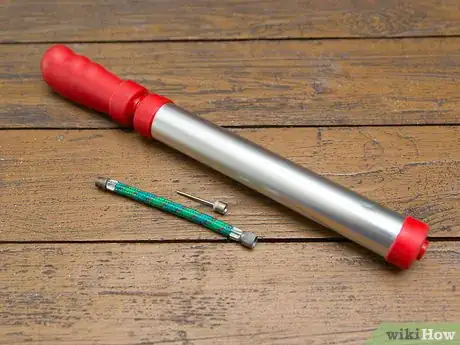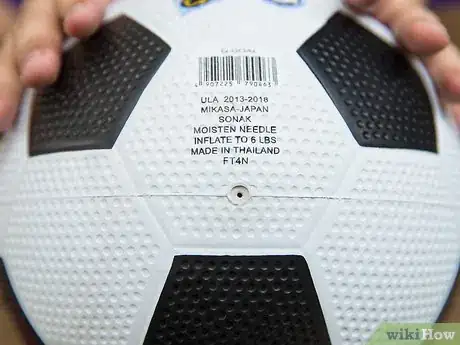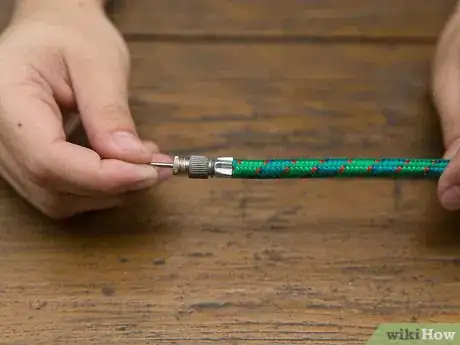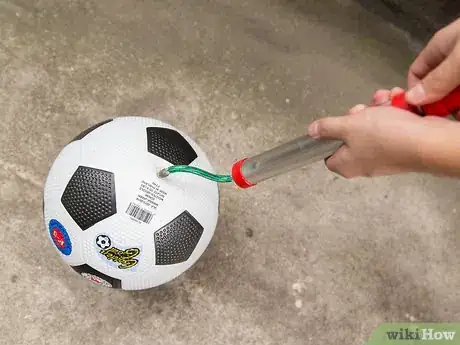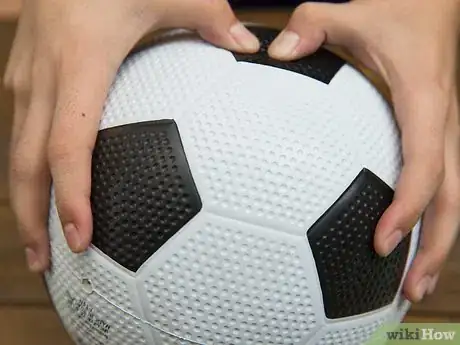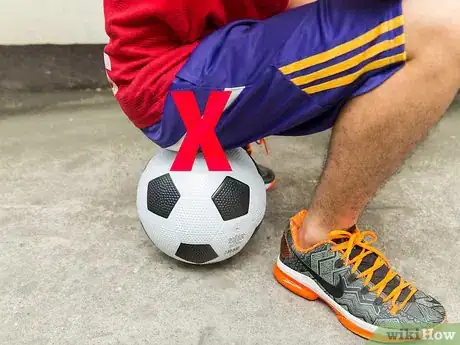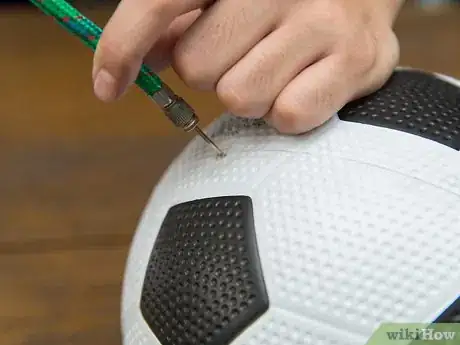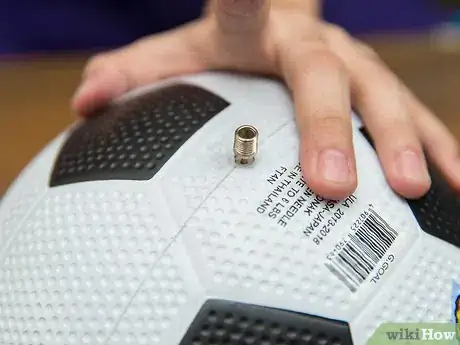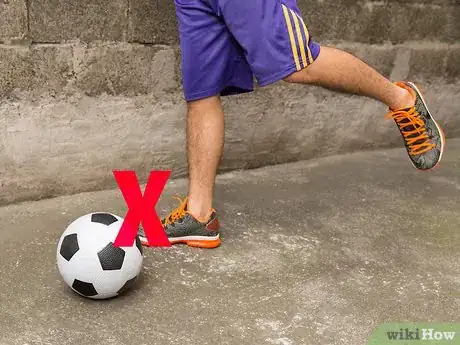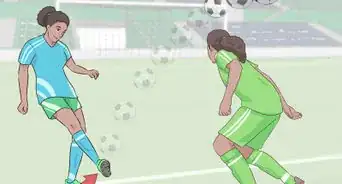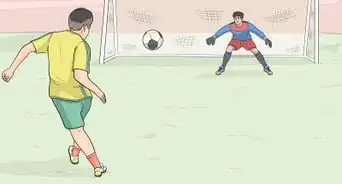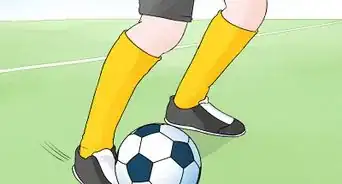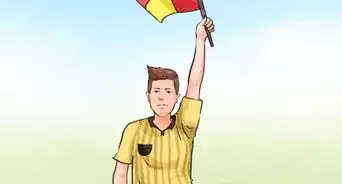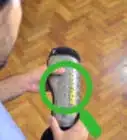wikiHow is a “wiki,” similar to Wikipedia, which means that many of our articles are co-written by multiple authors. To create this article, 19 people, some anonymous, worked to edit and improve it over time.
This article has been viewed 175,394 times.
Learn more...
A properly-inflated soccer ball can make a world of a difference in a match. Too little air pressure and the ball won't fly as far or as straight. Too much air pressure and the ball might burst, and definitely won't feel as good to kick. If you want your soccer ball to have a long and healthy life, keep it well-inflated and well-maintained.
Steps
Preparing to Inflate a Soccer Ball
-
1Get an air pump and a ball pump needle. They are easy to find and you can buy one at any sporting goods store. Invest in a good quality pump, air gauge, and keep a supply of pump needles on hand. Some pumps have an air gauge built in. If yours doesn't, make sure you get a low pressure gauge.
- You'll also need some silicone or glycerin oil for lubrication.
-
2Determine the ideal air pressure for your soccer ball. Check the manufacturer's manual to find the recommended air pressure level for your soccer ball. The recommended air pressure will be expressed either in lbs, psi, or bar, and typically will be between 6 lbs and 8 lbs.
- If the recommended pressure of your soccer ball is expressed in a different unit than what your air gauge reads, you'll need to convert. To convert bar to psi, multiple by 14.5037, or divide by the same amount to convert the other way. To convert bar to lbs, multiply by 10, or divide by the same amount to convert the other way.
Advertisement -
3Lubricate the needle and valve. Use either silicone or glycerin oil, and place a few drops in and around the valve in the soccer ball. This helps maintain the valve, and helps with the needle insertion. Lubricate the needle with the same oil.
Inflating a Soccer Ball
-
1Attach the ball pump needle into the air pump. It should slide right into the end of the air pump. Lock the needle in with the locking mechanism of the pump. Put the needle tip into the opening of the soccer ball valve.[1]
-
2Take the handle on the pump and start pumping. The ball will start to inflate. Go slowly so you don't over-inflate the ball and put unnecessary pressure on the seams. [2]
-
3Stop pumping once the gauge reaches the proper air pressure level. If your air pump has a built in gauge, just stop once the level on the gauge reaches the recommended air pressure. If your pump doesn't have a gauge, you'll have to pull out the needle and check the pressure with the gauge regularly once it starts to feel firm.[3]
Maintaining a Soccer Ball
-
1Don't abuse your soccer ball. Avoid kicking it hard against walls. Never sit or stand on your soccer ball. This puts too much pressure on the stitching of the ball and can cause it to become warped or eventually burst.[4]
-
2Check the pressure often. Ideally, you'll want to check the air pressure of your soccer ball with a gauge every couple of days. The more often it's used, the more often the pressure should be checked. Balls with butyl bladders will retain air much longer than balls with latex bladders.
-
3Deflate your ball slightly after a game. Although not necessary, manufacturers recommend that after a match, you should let a little air out of the your soccer ball. This reduces the stress on the ball when it's not in use. Just don't forget to re-inflate it before using it again.
-
4Play on smooth or soft surfaces. Although quite sturdy, soccer balls are vulnerable to exposure to sharp and abrasive surfaces. Stick to playing either on smooth wooden floors, grass, or turf. Surfaces like gravel and asphalt can damage the ball.[5]
Community Q&A
-
QuestionCan I use normal needles?
 Phoenix BetaCommunity AnswerYes. They will inflate it, but make sure they are not too thick.
Phoenix BetaCommunity AnswerYes. They will inflate it, but make sure they are not too thick. -
QuestionWhy shouldn't I sit on a soccer ball?
 Community AnswerIt can make some of the air deflate, resulting in the pressure becoming uneven and the ball being lopsided.
Community AnswerIt can make some of the air deflate, resulting in the pressure becoming uneven and the ball being lopsided. -
QuestionCan I deflate the ball to put it in my luggage and then inflate it again?
 Community AnswerYes. Just gently deflate the ball before packing and make sure not to accidentally put any holes in it.
Community AnswerYes. Just gently deflate the ball before packing and make sure not to accidentally put any holes in it.
Warnings
- If the ball is pumped too much it can hurt to kick or head, and the extra pressure will put stress on the ball's stitching and bladder.⧼thumbs_response⧽
References
- ↑ https://www.youtube.com/watch?v=JTFuuxpKy_k
- ↑ https://www.youtube.com/watch?v=JTFuuxpKy_k
- ↑ http://howto.yellow.co.nz/sports-and-fitness/footballsoccer/how-to-care-for-your-soccer-ball/
- ↑ http://howto.yellow.co.nz/sports-and-fitness/footballsoccer/how-to-care-for-your-soccer-ball/
- ↑ http://howto.yellow.co.nz/sports-and-fitness/footballsoccer/how-to-care-for-your-soccer-ball/
About This Article
To inflate a soccer ball, all you need is an air pump and ball pump needle, which you can find at any sporting goods store. Before you inflate the ball, check the recommended air pressure, which is usually printed on the bottom of the ball. Most soccer balls need between 6 and 8 pounds of air pressure. To inflate the ball, first, slide the needle into the end of the air pump and lock it in place with the locking mechanism on the pump. Then, put the needle tip into the opening of the soccer ball valve. Take the handle on the pump and start pumping. Make sure to go slowly so you don’t over-inflate the ball. If your pump has a PSI measure, you’ll want to stop somewhere between 87 and 100 to get the right amount of air pressure. To learn how to keep your soccer ball in good shape, read on!
